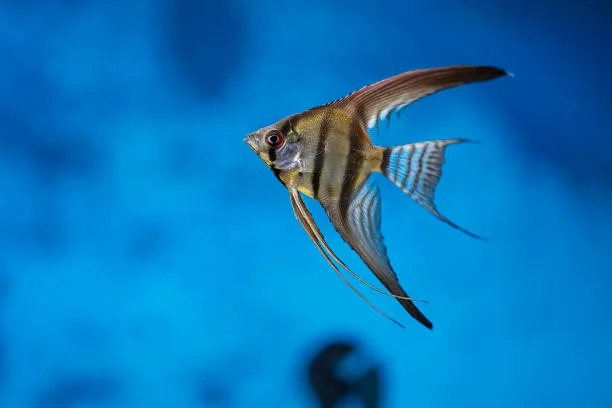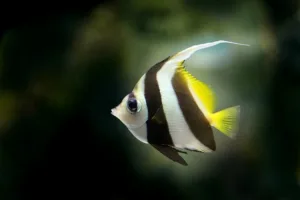Angelfish are known for their striking appearance and graceful demeanor, making them a popular choice for freshwater aquarium enthusiasts. However, like all living creatures, angelfish are susceptible to various diseases. As a responsible aquarist, it’s crucial to be aware of these ailments and how to treat them. In this comprehensive guide, we will delve into the most common angelfish diseases and provide insights on how to effectively manage and prevent them.
Common Angelfish Diseases
1. Ichthyophthirius multifiliis (Ich)
Ich, often referred to as white spot disease, is one of the most prevalent diseases that affect angelfish. It’s caused by a protozoan parasite known as Ichthyophthirius multifiliis. Infected fish display symptoms like small white cysts on their skin, gills, and fins.
Treatment:
- Increase the water temperature gradually to around 82-86°F (28-30°C). Ich parasites are sensitive to temperature changes, and raising the temperature can speed up their life cycle, making them more susceptible to treatment.
- Administer over-the-counter anti-parasitic medications, such as copper-based or formalin-based treatments. Follow the dosage instructions carefully, as overdosing can harm your fish.
- Isolate the infected fish to prevent the disease from spreading to other tank mates.
2. Fin Rot
Fin rot is a bacterial infection caused by various opportunistic pathogens. It typically manifests as the gradual deterioration of the fins, starting with fraying and progressing to tissue loss.
Treatment:
- Ensure pristine water conditions with proper filtration and regular water changes.
- Administer antibiotics such as Maracyn or Maracyn-2, as prescribed, to treat the underlying bacterial infection.
- Improve the fish’s diet with high-quality food to boost their immune system, aiding in the recovery process.
3. Columnaris
Columnaris, also known as cotton wool disease, is a bacterial infection that affects angelfish and other aquarium fish. It presents itself as white, thread-like lesions on the fish’s skin or gills, resembling cotton.
Treatment:
- Isolate the infected fish to prevent the disease from spreading.
- Administer antibiotics such as Furan-2 or Kanamycin, as directed, to target the bacteria responsible for the infection.
- Maintain optimal water quality, as poor water conditions can exacerbate the disease.
4. Swim Bladder Disorder
Swim bladder disorder affects a fish’s buoyancy and ability to swim properly. It can be caused by several factors, including overfeeding, constipation, or bacterial infection.
Treatment:
- Feed your angelfish a balanced diet and avoid overfeeding.
- Isolate the affected fish in a quarantine tank to monitor its condition closely.
- In some cases, fasting the fish for a couple of days can help alleviate the disorder, as it can clear any blockages in the digestive system.
5. Velvet Disease
Velvet disease is caused by the protozoan parasite Piscinoodinium pillulare and is characterized by a fine, yellowish-gold dust-like coating on the fish’s skin and gills.
Treatment:
- Increase the water temperature to 82-86°F (28-30°C) to speed up the parasite’s life cycle and make it more susceptible to treatment.
- Use copper-based or formalin-based medications to target the parasites.
- Isolate the infected fish to prevent the disease from spreading.
Prevention Strategies
Preventing angelfish diseases is often more effective than treatment. Here are some key prevention strategies:
1. Quarantine New Fish
Always quarantine new fish before adding them to your main tank. This will help you identify and treat any potential diseases before they can spread.
2. Maintain Optimal Water Conditions
Clean and well-maintained water conditions are crucial. Regular water changes, efficient filtration, and proper water parameters are essential for a healthy aquarium.
3. Balanced Diet
Feed your angelfish a well-balanced diet to ensure they receive essential nutrients and maintain a strong immune system.
4. Avoid Overcrowding
Overcrowding can stress fish and increase the likelihood of disease transmission. Maintain a suitable fish-to-tank ratio.
5. Quarantine New Decorations
New decorations or plants can introduce pathogens into your tank. Quarantine them or thoroughly clean and disinfect before adding them to your aquarium.
Lesser-Known Angelfish Diseases
A. Cotton Wool Disease (Saprolegnia)
Cotton Wool Disease, caused by the fungal pathogen Saprolegnia, can affect angelfish, leading to the development of fluffy, cotton-like growths on their skin, fins, and gills. This disease is often secondary to an underlying issue, such as physical injury, poor water quality, or stress.
Symptoms:
- White, fuzzy growths on the fish’s body and fins.
- Decreased activity and appetite.
- Ulcers or lesions on the skin.
Treatment:
- Isolate affected fish to prevent the disease from spreading.
- Treat with antifungal medication, following the manufacturer’s instructions.
- Improve water quality and reduce stress factors in the tank.
B. Hexamita (Hexamita sp.)
Hexamita, also known as Hole-in-the-Head disease, is a protozoan parasite that can affect angelfish and other cichlids. It primarily targets the digestive system, causing erosion and pitting of the head, lateral line, and other areas of the fish’s body.
Symptoms:
- Small pits or holes on the head and lateral line.
- Reduced appetite and weight loss.
- Lethargy and darkening of the skin.
Treatment:
- Isolate infected fish and treat with a metronidazole-based medication.
- Adjust the diet to include anti-parasitic foods, such as medicated pellets.
- Maintain excellent water quality and reduce stress factors.
Understanding Angelfish Dying Symptoms
Angelfish, like any other living creatures, can sometimes experience health issues that may lead to their demise. Recognizing the symptoms of a sick or dying angelfish is crucial for addressing the problem promptly and, in some cases, potentially saving your fish. In this guide, we will explore common angelfish dying symptoms and the possible underlying causes.
Common Dying Symptoms in Angelfish
- 1. Lethargy
- Lethargy is one of the early signs that something might be wrong with your angelfish. When you notice your fish becoming unusually inactive, resting at the bottom of the tank, or spending most of its time hiding, it could indicate a health problem.
- 2. Loss of Appetite
A sudden loss of appetite can be a worrying sign. If your angelfish refuses to eat or displays reduced interest in food, it may indicate an underlying issue. This symptom can lead to weight loss and weakness.
- 3. Changes in Coloration
Angelfish may exhibit changes in coloration when they are unwell. They might appear paler or darker than usual, or they may develop spots, discoloration, or unusual patterns on their skin.
- 4. Gasping for Air
If your angelfish is seen at the water’s surface, gasping for air, it could suggest a problem with oxygen levels in the tank or an issue with the fish’s gills. Poor water quality can be a common cause.
- 5. Clamped Fins
Angelfish with clamped fins often appear as if their fins are held tightly against their bodies. This is a sign of distress or discomfort and can be a response to various health problems.
- 6. Bloating or Swelling
Swelling in the abdominal region or around the eyes can be indicative of various internal issues, including constipation, organ failure, or infection.
- 7. Scratching or Flashing
When angelfish rub themselves against objects in the tank, it may be a response to skin irritation or the presence of parasites. This behavior is known as flashing and can signal discomfort.
- 8. Visible Sores or Lesions
Open sores, lesions, or ulcers on the angelfish’s skin or fins can be a sign of bacterial or fungal infections. These can worsen rapidly if left untreated.
- 9. Abnormal Swimming Patterns
Uncoordinated, erratic, or tilted swimming can indicate neurological problems or issues with the fish’s swim bladder.
Possible Underlying Causes
Understanding the underlying causes of these symptoms is crucial for effective intervention:
- Poor Water Quality: Inadequate filtration, high ammonia, nitrite, or nitrate levels can stress fish and lead to various health issues.
- Parasites and Infections: External parasites (e.g., ich) and bacterial or fungal infections can cause a range of symptoms, including skin lesions and changes in behavior.
- Dietary Issues: Overfeeding, poor nutrition, or constipation can lead to digestive problems and other related symptoms.
- Stress: Angelfish are sensitive to changes in their environment. Stressors like sudden water parameter shifts, overcrowding, or territorial disputes can impact their health.
- Age and Genetics: Sometimes, angelfish may succumb to age-related issues or genetic predispositions.
What to Do When You Suspect Dying Symptoms
- Isolate the Sick Fish: If possible, move the sick angelfish to a quarantine tank to prevent the potential spread of disease.
- Water Testing: Check and maintain optimal water parameters (temperature, pH, ammonia, nitrite, nitrate) and conduct a water test.
- Observation: Monitor the fish closely, noting any additional changes in behavior or appearance.
- Consult an Expert: If the condition does not improve or worsens, seek advice from a knowledgeable aquarist or a veterinarian specializing in fish.
- Treatment: Depending on the diagnosis, follow appropriate treatment protocols, which may include medication, dietary adjustments, and improved tank conditions.
Remember that prevention is often the best approach. Maintain good water quality, feed a balanced diet, and provide a stress-free environment to reduce the risk of angelfish health problems. Regular observation and quick action are key to ensuring the well-being of your beloved aquatic pets.










